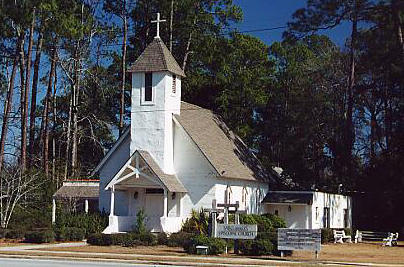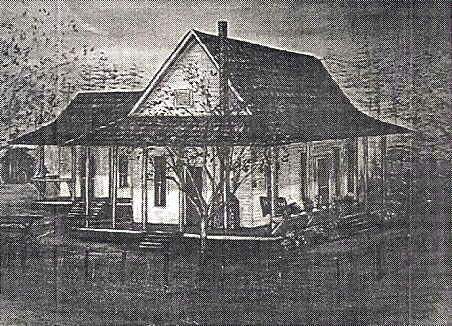| St. Mark's Episcopal Church of Woodbine

History:
Permission to reprint this information on The Crypt was granted by
Father David Somerville on Jan. 24, 2001.
This brochure was compiled from old church records and records stored
at the Bryan-Lang Historical Library on Camden Avenue and 4th Street in
Woodbine. It was compiled by Dr. John H. Christian of the Library and St.
Marks parishioners Libby Bass and Bettie Cottle.
St. Marks Episcopal Church Welcomes You!
When you cross over the Satilla River Bridge into the town of Woodbine,
your eyes catch the steeple of a very unique little church sitting on the
left of the four-lane, paved highway, U.S. 17. This is St. Marks Episcopal
Church.
Mr. J.K. Bedell deeded one-half acre of land to the church in 1898. In 1900, the men of the community combined their skills to construct a church that would be a thing of beauty and endure through the ages.
The building was constructed from local materials. The timber was brought from the local mills at Satilla Bluff, which is located about 5 miles east of town on the south bank of the Satilla
River. Ballast rock from sailing ships was used for reinforcement at strategic locations throughout the building. The walls are constructed from tabby, which is made from burned oyster shells, covers the exterior. These shells came from the waterways of Camden County. St. Marks Church was the last building constructed using tabby until the completion of the County Library during the 1980s.

As you step into this picturesque Church with a noble and historic past, your eyes are drawn to the
brilliant colors cast from the stained glass windows. These windows came to St. Marks from a parish in England. The arches once used in the church, and the Bishop's Chair were hand tooled by the late
E.P. Noyes of the Ceylon Community near Satilla Bluff. The lights in the Church were donated to the memory of
Reverend David Watson Winn. The gold Crucifix
carried in procession by acolytes was given in memory of Dr. Charles
H. Lee, a nephew of General Robert E. Lee. Each pew has memorial plaques commemorating past members of St. Marks Church.
Most of the current parishioners of St. Marks Church are descended from families living near Satilla Bluff. These families attended St. Clements Church, one of the first churches In northern
Camden County. St. Clements was a wooden building which stood on the banks of the Satilla River. This building was later sold to the
William Miller family as a home. This building is still standing a short distance from its original location at Satilla Bluff.
In 1953, the Georgia Highway Department wished to construct anew bridge across the Satilla River for U.S. Highway 17. St. Marks Church was too near the proposed construction. The
Highway Department brought in heavy equipment and timbers along with workers skilled in moving buildings. The Church was moved several feet to the east from its original location. The only damage to the Church was a small crack in the southern wall of the building. St. Marks Episcopal Church is proud of its building. It was built with the loving hands and in memory of its pioneer families who keep our Episcopal Faith alive with the help of God.
|